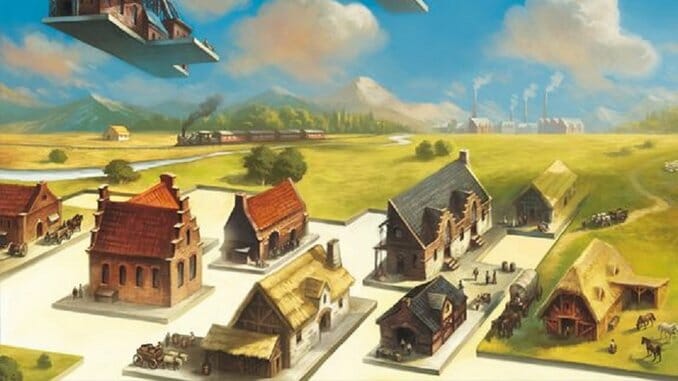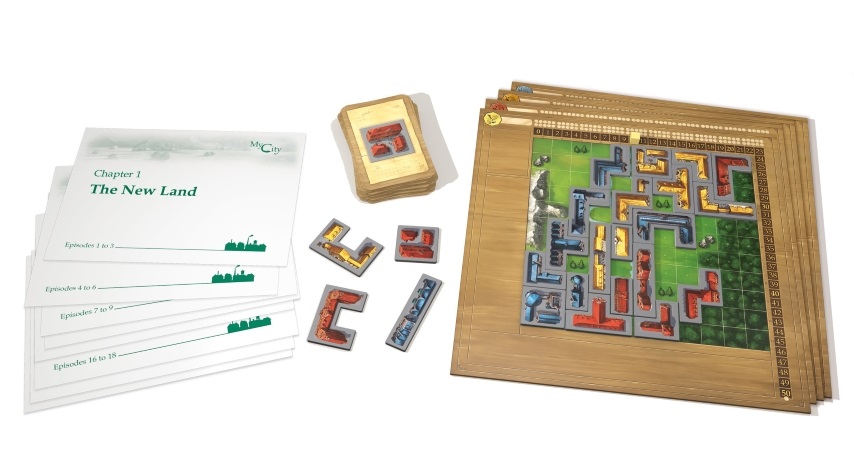
Reiner Knizia is the most prolific board game designer in the industry, but until his newest game, My City, came out, he didn’t have a legacy game—one where the rules and components change from one play to the next—to his credit. My City has been a hit, earning a Spiel des Jahres (game of the year) nomination, probably because it brings a much-needed simplicity to the legacy space, with a very gradual ramp-up in the rules and some familiar mechanics throughout.
My City is a tile-placement game, definitely a Knizia specialty (Samurai, Tigris & Euphrates, Yellow & Yangtze), and has the Tetris-like polyomino tiles that have been so in vogue the last few years in board games. Each player starts with a set of 24 of those tiles in eight shapes, three of each, in differing colors; and with a square board with gridlines on it, with a river splitting the grid in two. The remaining squares all show open fields, trees, forests, or rocks. There’s a common deck of 24 cards showing those tile shapes and colors that all players have.
In the first game, the simplest of all, players will cycle through that deck, and when each card is revealed, all players will simultaneously place that tile from their supply onto their boards. You can place those tiles on any open fields, trees, or rocks, but not on the forests on the left and right edges of your board, and not across the river. You can decline to play a building, losing one point if you do so (everyone starts with 10 points), but if you get to the point where you can’t legally play the building on the card, you’re done placing for that game.

The scoring in the first game is simple enough—you gain two points for every square with trees still visible, lose two points for every square with rocks still visible, and lose one point for every square of open field still visible. The player with the most points gets to color in two progress squares on their board; the winner of the entire campaign is the player with the most total progress squares colored in. The player with the lowest score, whether you’re playing with two players or up to four, gets to add a sticker showing one tree on any square with an open field on their board.
The second game—these aren’t spoilers, since you see the rules for games one through three when you open the first envelope—adds a scoring twist based on the colors of the buildings. You get additional points for the largest contiguous cluster of buildings of any single color on your board, one point per building in the group. The third game gives each player a sticker showing a well, and you can score four additional points if you surround it on all four sides with different buildings (it’s all or nothing, zero points or four). You can cover up the well, but you cede the bonus by doing so.
My City has 24 ‘episodes’ contained in its eight envelopes, and the new rules for each episode can vary from things as simple as adding a few stickers to adding entirely new tiles to the game with their own scoring quirks. It’s a gradual change in the rules, which lowers the barrier to entry for players unfamiliar with legacy games, and for players who just aren’t that familiar with this style of board game, period. It’s one of the most family-friendly legacy games I’ve seen, and the city-building theme is a classic of board and videogames, although it becomes more evident within the game as you get deeper into the episodes (I’d say envelope three is where it starts to feel more like a city).
Games of My City are quick, about a half-hour each, and while the box says ages 10 and up, I’d put the minimum age around 8 to play this reasonably well. The heart of the game is always the tile-placement mechanic—managing the restrictions on the space you have, seeing what tiles you still have to play—and that’s not that significant a bar for younger players to clear. It’s Knizia’s best new game in a while; I haven’t played Babylonia, from 2019, but I think this rivals The Quest for El Dorado (another Spiel nominee) for his best game of the last 10 years.
Keith Law is the author of The Inside Game and Smart Baseball and a senior baseball writer for The Athletic. You can find his personal blog the dish, covering games, literature, and more, at meadowparty.com/blog.